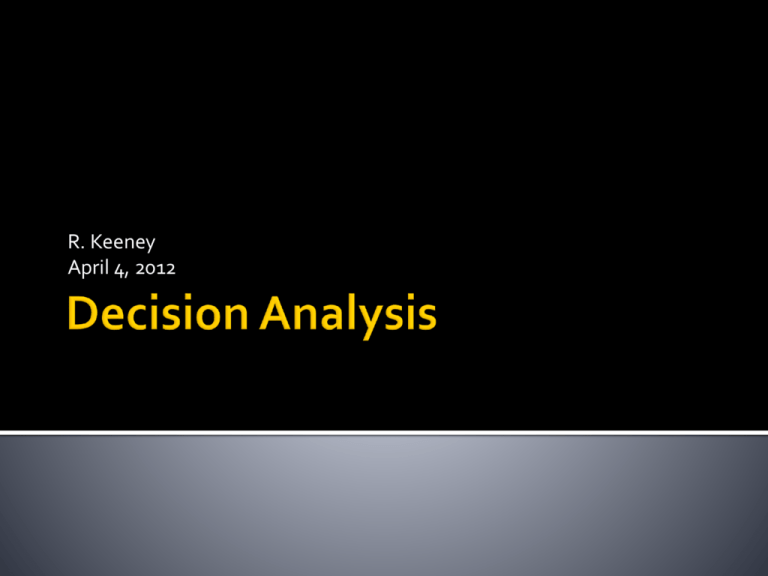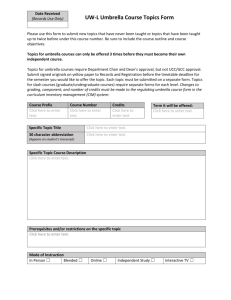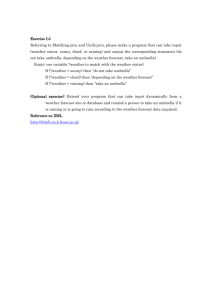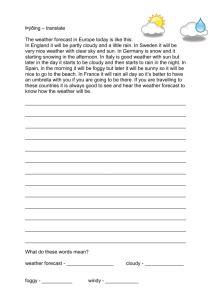No Rain
advertisement

R. Keeney April 4, 2012 A decision maker wants to behave optimally but is faced with an opponent Nature – offers uncertain outcomes Competition – another optimizing decision maker We focus on simple examples using payoff matrix Decisions for one actor are the rows and for the other are the columns Intersecting cells are the payoffs ▪ Bimatrix (two payoffs in the cells) One decision maker has to decide whether or not to carry an umbrella Decisions are compared for each column If it rains, Umbrella is best (5>0) If no rain, No Umbrella is best (4>1) Rain No Rain Umbrella 5 1 No Umbrella 0 4 The play made by nature (rain, no rain) determines the decision maker’s optimal strategy Assume I have to make the decision in advance of knowing whether or not it will rain Rain No Rain Umbrella 5 1 No Umbrella 0 4 I know that rain is possible, but no idea how likely it is to occur Maxi-min decision making helps us formulate a plan in an optimal fashion Maximize the minimums for each decision ▪ If I take my umbrella, what is the worst I could do? ▪ If I don’t take my umbrella, what is the worst I could do? Rain No Rain Umbrella 5 1 No Umbrella 0 4 Comparing the two worst case scenarios Payoff of 1 for taking umbrella Payoff of 0 for not taking umbrella An optimal choice under this framework is then to take the umbrella no matter what since 1 > 0 Rain No Rain Umbrella 5 1 No Umbrella 0 4 A lot of decisions are made this way Identify the worst that could happen, choose a course that has a “worst case scenario” that is least detrimental Framework implies that people are risk averse Focus on downside outcomes and try to avoid the worst of these Assumes probabilistic knowledge of outcomes is not available or not able to be processed What if I know probabilities of events? Wake up and check the weather forecast, tells me 50% chance of rain Take a weighted average (i.e. the expected value) of outcomes for each decision and compare them Umbrella No Umbrella Rain (p=0.5) 5 0 No Rain (p=0.5) 1 4 Rain No Rain EV (p=0.5) (p=0.5) (Sum over row) Umbrella 5*0.5 1*0.5 3.0 No 0*0.5 4*0.5 2.0 Umbrella Given the probability of rain, the EV for taking my umbrella is higher so that is the optimal decision Rain No Rain EV (p=0.25) (p=0.75) (Sum over row) Umbrella 5*0.25 1*0.75 2.0 No 0*0.25 4*0.25 3.0 Umbrella Given the lower probability of rain, the EV for taking my umbrella is lower so no umbrella is my optimal decision Umbrella No Umbrella Rain (p=x) 5*x 0*x No Rain EV (p=1-x) (Sum over row) 1*(1-x) 5x+(1-x) 4*(1-x) 0x+4(1-x) Setting the two values in the last column equal gives me their EV’s in terms of x. Solving for x gives me a breakeven probability. Umbrella No Umbrella Rain (p=x) 5*x 0*x Umbrella: No Umbrella: No Rain EV (p=1-x) (Sum over row) 1*(1-x) 5x+(1-x) 4*(1-x) 0x+4(1-x) 4x + 1 4 – 4x Setting equal: 4x + 1 = 4 – 4x -> 8x – 3 =0 X = 0.375 If rain forecast is > 37.5%, take umbrella If rain forecast is < 37.5%, do not take umbrella The tough work is not the decision analysis it is in determining the appropriate probabilities and payoffs Probabilities ▪ Consulting and market information firms specialize in forecasting earnings, prices, returns on investments etc. Payoffs ▪ Economics and accounting provide the framework here ▪ Profits, revenue, gross margins, costs, etc. Rain No Rain Wear clothing 100 100 Wear no clothing -100 -50 Decision is whether or not to wear clothing If it rains prefer to wear clothing ▪ Get sick from rain and get arrested If it doesn’t rain prefer to wear clothing ▪ Don’t get sick but still arrested Wearing clothing is a Dominant Decision Nature’s play has no influence on the decision Weather effects how much and what type of clothing just as it effects our decision on umbrella (where we saw a split decision) Player 1 Action 1 Action 2 Player 2 Action 1 Action 2 P1, P2 P1, P2 P1, P2 P1, P2 Each player has two actions and each player’s action has an impact on their own and the opponent’s payoff. Payoffs are listed in each intersecting cell for player 1 (P1) and player 2 (P2). Prisoner 2 Prisoner 1 Confess Don’t Confess Confess P1 = Life jail P2 = Life jail P1 = Death P2 = Free Don’t Confess P1 = Free P2 = Death P1 = 1 year jail P2 = 1 year jail Two criminals apprehended with enough evidence to prosecute for 1 year sentences Suspected of also committing a murder Outcomes range from going free to death penalty Prisoner 2 Prisoner 1 Confess Don’t Confess Confess P1 = Life jail P1 = Death Don’t Confess P1 = Free P1 = 1 year jail If Prisoner 2 confesses then prisoner 1 optimally confesses since: Life jail > Death If Prisoner 2 does not confess then prisoner 1 optimally confesses since: Free > 1 year in jail Confession is a dominant decision for prisoner 1 Optimally confesses no matter what prisoner 2 does Prisoner 1 Prisoner 2 Confess Don’t Confess Confess P2 = Life jail P2 = Death Don’t Confess P2 = Free P2 = 1 year jail Prisoner 2 faces the same payoffs as prisoner 1 Prisoner 2 has same dominant decision to confess Optimally confesses no matter what prisoner 1 does Prisoner 2 Prisoner 1 Confess Don’t Confess Confess P1 = Life jail P2 = Life jail P1 = Death P2 = Free Don’t Confess P1 = Free P2 = Death P1 = 1 year jail P2 = 1 year jail This is far from the best outcome overall for the prisoners If neither confesses, they get only one year in jail But, if either does not confess, the other can go free just by confessing while the other gets the death penalty Incentive is to agree to not confess, then confess to go free Company 2 Company 1 Low Prices High Prices Low Prices C1 = 2000 C2 = 2000 C1 = 0 C2 = 13000 High Prices C1 = 13000 C2 = 0 C1 = 10000 C2 = 10000 Two companies set prices and earn profits If C2 sets low price, C1 sets low price 2000>0 If C2 sets high price, C1 sets low price 13000>10000 ▪ Low prices are a dominant decision for C1 Company 2 Company 1 Low Prices High Prices Low Prices C1 = 2000 C2 = 2000 C1 = 0 C2 = 13000 High Prices C1 = 13000 C2 = 0 C1 = 10000 C2 = 10000 C2 faces the same payoffs Also has low prices as a dominant decision Both earn 2000 If they collude (with a contract) they could both earn 10000 ▪ Illegal contract in most cases Decision analysis is a more complex world for looking at optimal plans for decision makers Uncertain events and optimal decisions by competitors limit outcomes in interesting ways In particular, the best outcome for both decision makers may be unreachable because of your opponent’s decision and the incentive to deviate from a jointly optimal plan when individual incentives dominate Broad application: Companies spend a lot of time analyzing competition ▪ Implicit collusion: Take turns running sales (Coke and Pepsi)







